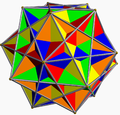| Great ditrigonal icosidodecahedron | |
|---|---|
 | |
| Type | Uniform star polyhedron |
| Elements | F = 32, E = 60 V = 20 (χ = −8) |
| Faces by sides | 20{3}+12{5} |
| Coxeter diagram | |
| Wythoff symbol | 3/2 | 3 5 3 | 3/2 5 3 | 3 5/4 3/2 | 3/2 5/4 |
| Symmetry group | Ih, [5,3], *532 |
| Index references | U 47, C 61, W 87 |
| Dual polyhedron | Great triambic icosahedron |
| Vertex figure |  ((3.5)3)/2 |
| Bowers acronym | Gidtid |

In geometry, the great ditrigonal icosidodecahedron (or great ditrigonary icosidodecahedron) is a nonconvex uniform polyhedron, indexed as U47. It has 32 faces (20 triangles and 12 pentagons), 60 edges, and 20 vertices. [1] It has 4 Schwarz triangle equivalent constructions, for example Wythoff symbol 3 | 3 5⁄4 gives Coxeter diagram ![]()
![]()
![]()
![]() =
= ![]()
![]()
![]()
![]()
![]() . It has extended Schläfli symbol a{5⁄2,3} or c{3,5⁄2}, as an altered great stellated dodecahedron or converted great icosahedron.
. It has extended Schläfli symbol a{5⁄2,3} or c{3,5⁄2}, as an altered great stellated dodecahedron or converted great icosahedron.
Contents
Its circumradius is times the length of its edge, [2] a value it shares with the cube.





